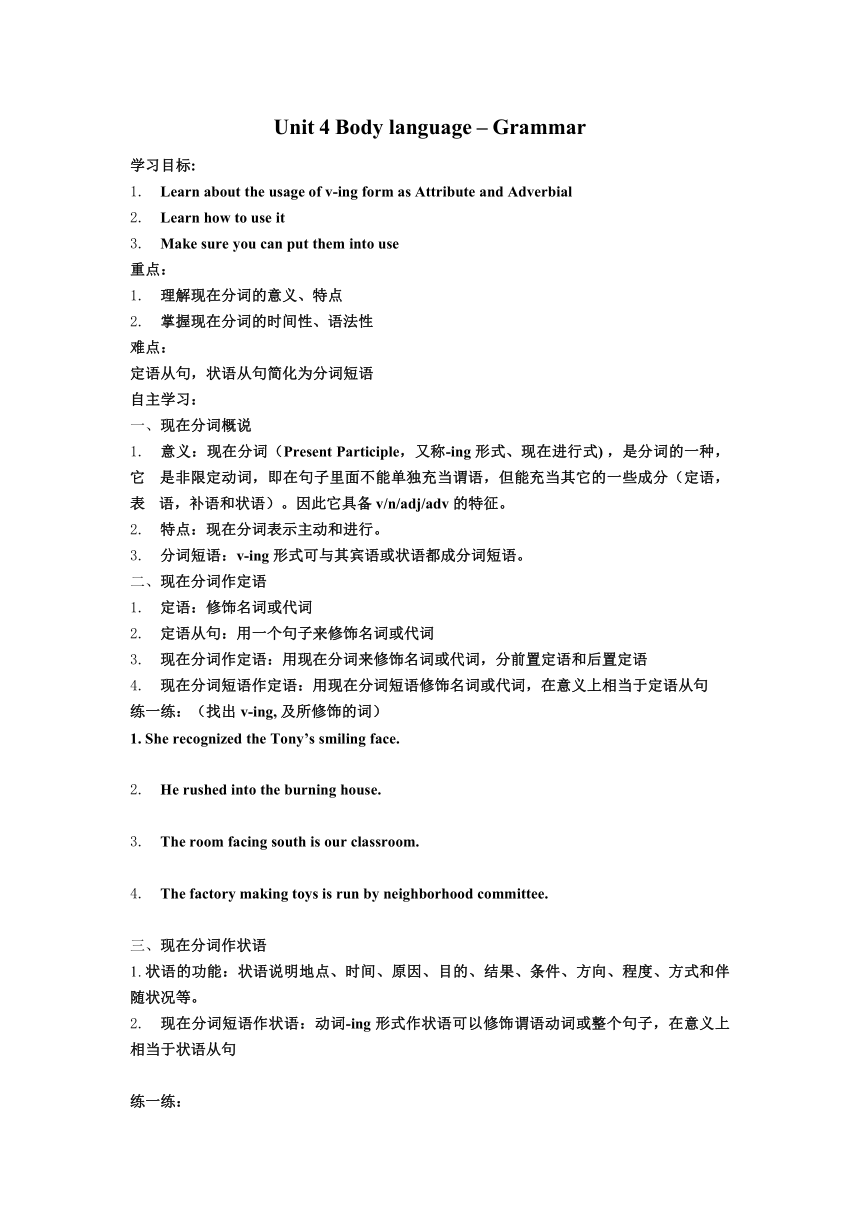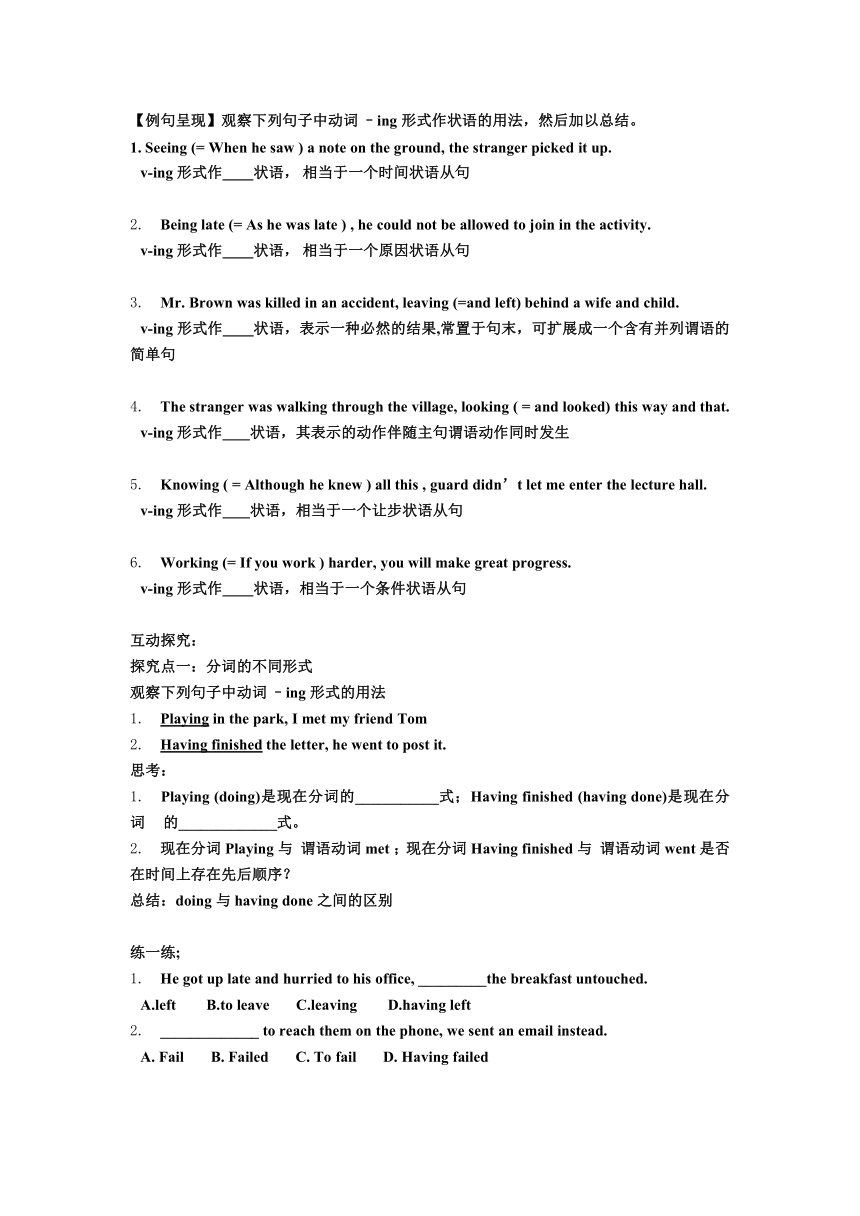高中英语人教版必修四Unit 4 Body language Grammar教学设计
文档属性
| 名称 | 高中英语人教版必修四Unit 4 Body language Grammar教学设计 |  | |
| 格式 | zip | ||
| 文件大小 | 17.4KB | ||
| 资源类型 | 教案 | ||
| 版本资源 | 人教版(新课程标准) | ||
| 科目 | 英语 | ||
| 更新时间 | 2022-01-24 15:57:34 | ||
图片预览


文档简介
Unit 4 Body language – Grammar
学习目标:
1. Learn about the usage of v-ing form as Attribute and Adverbial
2. Learn how to use it
3. Make sure you can put them into use
重点:
1. 理解现在分词的意义、特点
2. 掌握现在分词的时间性、语法性
难点:
定语从句,状语从句简化为分词短语
自主学习:
一、现在分词概说
1. 意义:现在分词(Present Participle,又称-ing形式、现在进行式) ,是分词的一种,它 是非限定动词,即在句子里面不能单独充当谓语,但能充当其它的一些成分(定语,表 语,补语和状语)。因此它具备v/n/adj/adv的特征。
2. 特点:现在分词表示主动和进行。
3. 分词短语:v-ing 形式可与其宾语或状语都成分词短语。
二、现在分词作定语
1. 定语:修饰名词或代词
2. 定语从句:用一个句子来修饰名词或代词
3. 现在分词作定语:用现在分词来修饰名词或代词,分前置定语和后置定语
4. 现在分词短语作定语:用现在分词短语修饰名词或代词,在意义上相当于定语从句
练一练:(找出v-ing, 及所修饰的词)
1. She recognized the Tony’s smiling face.
2. He rushed into the burning house.
3. The room facing south is our classroom.
4. The factory making toys is run by neighborhood committee.
三、现在分词作状语
1. 状语的功能:状语说明地点、时间、原因、目的、结果、条件、方向、程度、方式和伴随状况等。
2. 现在分词短语作状语:动词-ing形式作状语可以修饰谓语动词或整个句子,在意义上相当于状语从句
练一练:
【例句呈现】观察下列句子中动词 –ing 形式作状语的用法,然后加以总结。
1. Seeing (= When he saw ) a note on the ground, the stranger picked it up.
v-ing形式作 状语, 相当于一个时间状语从句
2. Being late (= As he was late ) , he could not be allowed to join in the activity.
v-ing形式作 状语, 相当于一个原因状语从句
3. Mr. Brown was killed in an accident, leaving (=and left) behind a wife and child.
v-ing形式作 状语,表示一种必然的结果,常置于句末,可扩展成一个含有并列谓语的简单句
4. The stranger was walking through the village, looking ( = and looked) this way and that.
v-ing形式作 状语,其表示的动作伴随主句谓语动作同时发生
5. Knowing ( = Although he knew ) all this , guard didn’t let me enter the lecture hall.
v-ing形式作 状语,相当于一个让步状语从句
6. Working (= If you work ) harder, you will make great progress.
v-ing形式作 状语,相当于一个条件状语从句
互动探究:
探究点一:分词的不同形式
观察下列句子中动词 –ing 形式的用法
1. Playing in the park, I met my friend Tom
2. Having finished the letter, he went to post it.
思考:
1. Playing (doing)是现在分词的___________式;Having finished (having done)是现在分词 的_____________式。
2. 现在分词Playing 与 谓语动词met ;现在分词Having finished 与 谓语动词went 是否在时间上存在先后顺序?
总结:doing 与 having done 之间的区别
练一练;
1. He got up late and hurried to his office, _________the breakfast untouched.
A.left B.to leave C.leaving D.having left
2. _____________ to reach them on the phone, we sent an email instead.
A. Fail B. Failed C. To fail D. Having failed
探究点二:分词的语法性
探究点三:如何把定语从句,状语从句简化为分词短语
1. 定语从句简化为分词短语
观察下列句子,找出其中的规律
①The book which belongs to Mary is lost.= The book belonging to Mary is lost.
②There’re many people who live in that village. = There’re many people living in that village.
③The girl who is writing a letter is Mary. = The girl writing a letter is Mary.
思考总结:
所给三个例句中去掉了定语从句的 ,将动词改为__________
2. 状语从句简化为分词短语
观察下列句子,找出其中的规律
①If you turn to the right, you’ll find the school.=Turning to the right, you’ll find the school.
②While I was walking along the street, I met Mary. =Walking along the street, I met Mary.
③After I had finished my work, I went home. =Having finished my work, I went home.
1. 分词短语是由状语从句变换而来的,用以表示时间、原因、条件、让步及附带情况。
2. 若状语从句于主句的主语相同时:
1)去连词 → 2)去主语 → 3)动词变分词
即: 连词+ 主语 + V. …, 主语 + V.
→ V.ing …, 主语+ V.
e.g. e.g.
As he was driven by hunger, he stole a cake.
→ Being driven by hunger, he stole a cake.
3. 若状语从句与主句的主语不同时:
1)去连词 2)前面的主语留下 3) 动词→分词
e.g. Notes:
1. 分词短语=连词+ 主语 + V.
e.g.
Being tired, I stopped to take a rest.
→ Because I was tired, I stopped to…
Knowing where I live, he never comes to see me.
→ Although he knows where I live, …
As it were fine, I went fishing with my father.
→ It being fine, I went fishing with …e.g.
Seen from the mountain, this city looks very beautiful at night.
→When it is seen from the mountain, this city…
2. 分词短语意义不清时,往往保留连词。但表示原因的连词 because, as等一定要省略。另外,表时间的连词放在句尾时常保留。
e.g.
If (I am) invited, I’ll go to the party.
When (I was) mailing a letter in the post office, I met Tom.
Animals can do many amazing things when properly trained
→ Not knowing what to do, she began to cry.
学习目标:
1. Learn about the usage of v-ing form as Attribute and Adverbial
2. Learn how to use it
3. Make sure you can put them into use
重点:
1. 理解现在分词的意义、特点
2. 掌握现在分词的时间性、语法性
难点:
定语从句,状语从句简化为分词短语
自主学习:
一、现在分词概说
1. 意义:现在分词(Present Participle,又称-ing形式、现在进行式) ,是分词的一种,它 是非限定动词,即在句子里面不能单独充当谓语,但能充当其它的一些成分(定语,表 语,补语和状语)。因此它具备v/n/adj/adv的特征。
2. 特点:现在分词表示主动和进行。
3. 分词短语:v-ing 形式可与其宾语或状语都成分词短语。
二、现在分词作定语
1. 定语:修饰名词或代词
2. 定语从句:用一个句子来修饰名词或代词
3. 现在分词作定语:用现在分词来修饰名词或代词,分前置定语和后置定语
4. 现在分词短语作定语:用现在分词短语修饰名词或代词,在意义上相当于定语从句
练一练:(找出v-ing, 及所修饰的词)
1. She recognized the Tony’s smiling face.
2. He rushed into the burning house.
3. The room facing south is our classroom.
4. The factory making toys is run by neighborhood committee.
三、现在分词作状语
1. 状语的功能:状语说明地点、时间、原因、目的、结果、条件、方向、程度、方式和伴随状况等。
2. 现在分词短语作状语:动词-ing形式作状语可以修饰谓语动词或整个句子,在意义上相当于状语从句
练一练:
【例句呈现】观察下列句子中动词 –ing 形式作状语的用法,然后加以总结。
1. Seeing (= When he saw ) a note on the ground, the stranger picked it up.
v-ing形式作 状语, 相当于一个时间状语从句
2. Being late (= As he was late ) , he could not be allowed to join in the activity.
v-ing形式作 状语, 相当于一个原因状语从句
3. Mr. Brown was killed in an accident, leaving (=and left) behind a wife and child.
v-ing形式作 状语,表示一种必然的结果,常置于句末,可扩展成一个含有并列谓语的简单句
4. The stranger was walking through the village, looking ( = and looked) this way and that.
v-ing形式作 状语,其表示的动作伴随主句谓语动作同时发生
5. Knowing ( = Although he knew ) all this , guard didn’t let me enter the lecture hall.
v-ing形式作 状语,相当于一个让步状语从句
6. Working (= If you work ) harder, you will make great progress.
v-ing形式作 状语,相当于一个条件状语从句
互动探究:
探究点一:分词的不同形式
观察下列句子中动词 –ing 形式的用法
1. Playing in the park, I met my friend Tom
2. Having finished the letter, he went to post it.
思考:
1. Playing (doing)是现在分词的___________式;Having finished (having done)是现在分词 的_____________式。
2. 现在分词Playing 与 谓语动词met ;现在分词Having finished 与 谓语动词went 是否在时间上存在先后顺序?
总结:doing 与 having done 之间的区别
练一练;
1. He got up late and hurried to his office, _________the breakfast untouched.
A.left B.to leave C.leaving D.having left
2. _____________ to reach them on the phone, we sent an email instead.
A. Fail B. Failed C. To fail D. Having failed
探究点二:分词的语法性
探究点三:如何把定语从句,状语从句简化为分词短语
1. 定语从句简化为分词短语
观察下列句子,找出其中的规律
①The book which belongs to Mary is lost.= The book belonging to Mary is lost.
②There’re many people who live in that village. = There’re many people living in that village.
③The girl who is writing a letter is Mary. = The girl writing a letter is Mary.
思考总结:
所给三个例句中去掉了定语从句的 ,将动词改为__________
2. 状语从句简化为分词短语
观察下列句子,找出其中的规律
①If you turn to the right, you’ll find the school.=Turning to the right, you’ll find the school.
②While I was walking along the street, I met Mary. =Walking along the street, I met Mary.
③After I had finished my work, I went home. =Having finished my work, I went home.
1. 分词短语是由状语从句变换而来的,用以表示时间、原因、条件、让步及附带情况。
2. 若状语从句于主句的主语相同时:
1)去连词 → 2)去主语 → 3)动词变分词
即: 连词+ 主语 + V. …, 主语 + V.
→ V.ing …, 主语+ V.
e.g. e.g.
As he was driven by hunger, he stole a cake.
→ Being driven by hunger, he stole a cake.
3. 若状语从句与主句的主语不同时:
1)去连词 2)前面的主语留下 3) 动词→分词
e.g. Notes:
1. 分词短语=连词+ 主语 + V.
e.g.
Being tired, I stopped to take a rest.
→ Because I was tired, I stopped to…
Knowing where I live, he never comes to see me.
→ Although he knows where I live, …
As it were fine, I went fishing with my father.
→ It being fine, I went fishing with …e.g.
Seen from the mountain, this city looks very beautiful at night.
→When it is seen from the mountain, this city…
2. 分词短语意义不清时,往往保留连词。但表示原因的连词 because, as等一定要省略。另外,表时间的连词放在句尾时常保留。
e.g.
If (I am) invited, I’ll go to the party.
When (I was) mailing a letter in the post office, I met Tom.
Animals can do many amazing things when properly trained
→ Not knowing what to do, she began to cry.
同课章节目录
